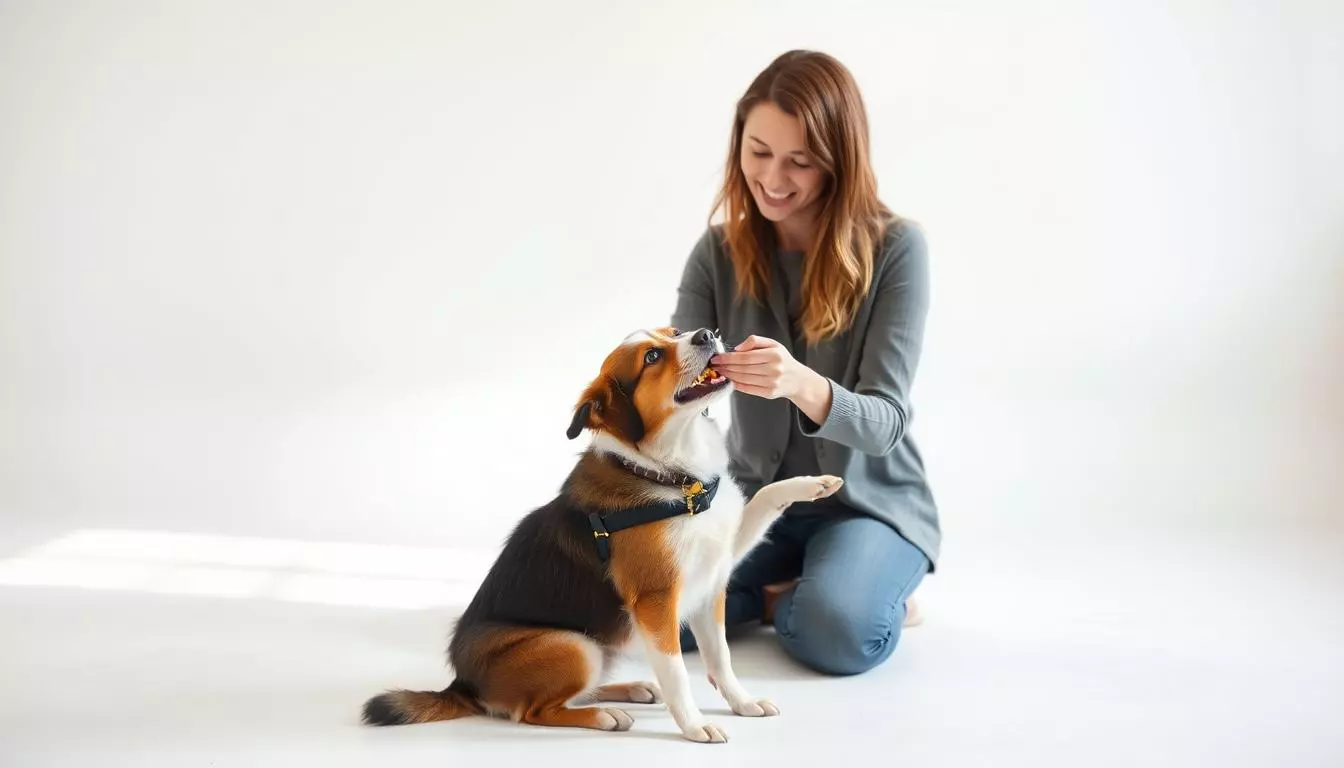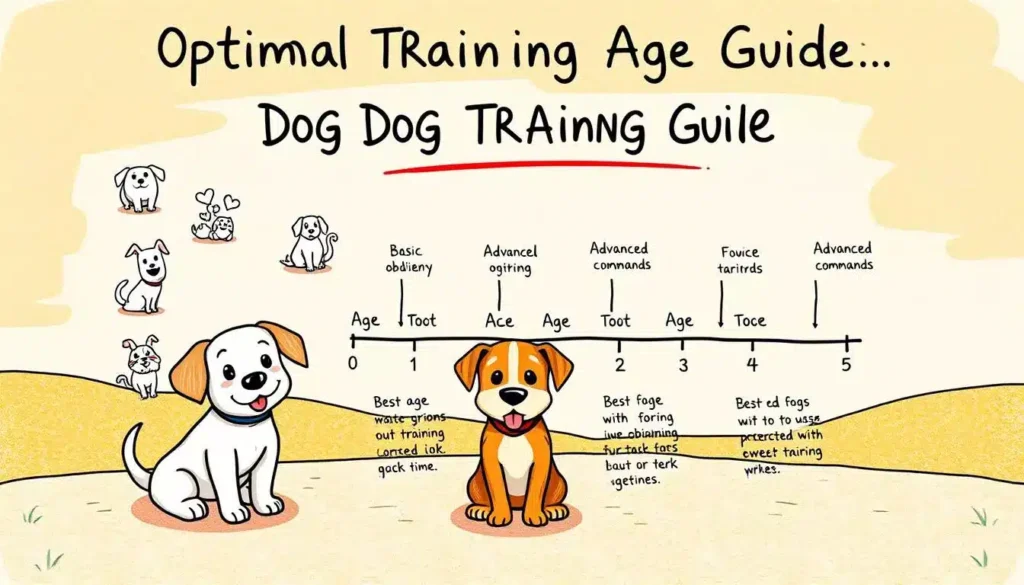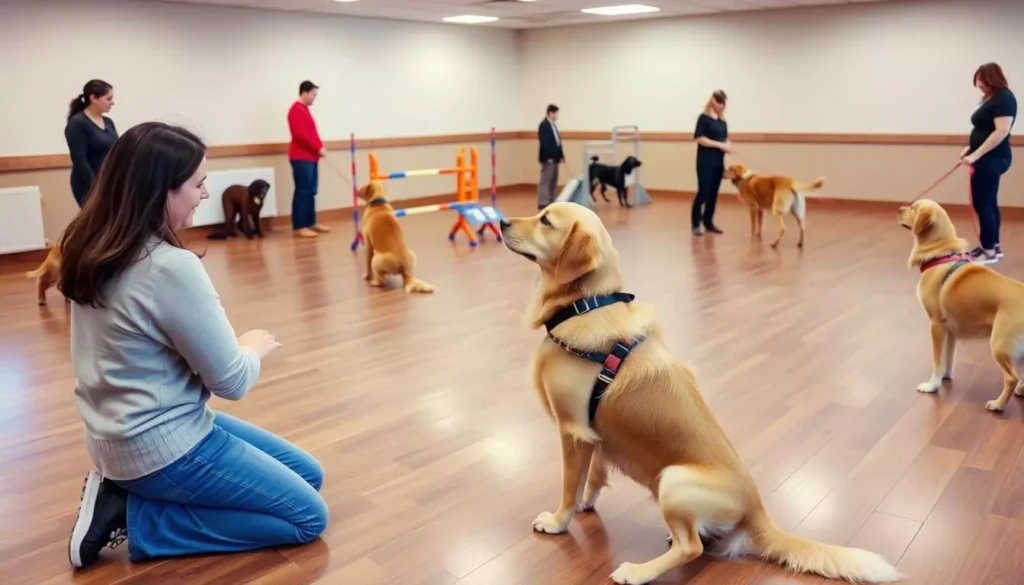As a dog owner, it's heartbreaking to feel like I'm talking to no one when I call my dog. I often wonder, "Why won't my dog listen to me?" It feels like they're ignoring me on purpose. But it's not that simple.
Understanding why they don't listen is key to a strong bond. By learning their language and needs, we can improve our communication. This turns confusion into teamwork.
Key Takeaways
- Dogs may not listen due to a lack of understanding or distractions in their environment.
- Common misconceptions about disobedience can hinder effective training.
- Effective communication is essential for improving canine responsiveness.
- Understanding a dog's age and learning capacity will enhance training efforts.
- Using positive reinforcement strengthens the bond between me and my dog.
Understanding Dog Behavior
To improve my dog listening skills, I need to understand canine behavior. Dogs are driven by instinct, past experiences, and training. Each dog has a unique personality shaped by these factors.
They see the world differently than humans, leading to possible miscommunication. Recognizing this is key to better understanding them.
Emotions and the environment greatly affect my dog's behavior. Stress or changes in their surroundings can make them anxious. For instance, a loud noise might upset them, making it hard to follow commands.
If I don't consider these factors, I might think they're being disobedient. But they're just reacting to their environment.
By acknowledging dogs' unique perspectives, we can communicate better. Understanding them deeply helps us build a stronger, more respectful relationship.
The Importance of Communication
Effective dog communication is key to a strong bond with my dog. Dogs mainly talk through body language and sounds. As a dog owner, I must watch my body language closely. It affects how my dog understands me.
Clear and consistent commands help my dog know what to do. This makes our training sessions better and strengthens our bond. Understanding my dog's way of communicating helps us connect deeper. This builds a relationship based on trust and respect.
| Communication Method | Description | Example |
|---|---|---|
| Body Language | Non-verbal signals dogs use to convey emotions and intentions. | Tail wagging indicates excitement or happiness. |
| Vocalization | Sounds dogs make to express their feelings or alert owners. | Barking can signal alertness or a need for attention. |
| Eye Contact | Direct gaze that can indicate trust or a desire for engagement. | Sustained eye contact while training reinforces obedience. |
Using good communication in dog training makes things better for both of us. It leads to more fun times together. This builds a rewarding relationship based on mutual respect.
Why Does My Dog Not Listen to Me?
Understanding why my dog may not listen is key to solving disobedience issues. I often think it's because they're stubborn. But, digging deeper, I find many factors affect their listening, none of which are about not wanting to obey.
Common Misconceptions About Disobedience
Many owners think their dogs are disobedient. But, this is often because of a misunderstanding. Dogs might not listen because they don't understand the command or are distracted. Knowing this can change how I see dog disobedience.
Factors Influencing Your Dog's Obedience
Several things can affect my dog's listening. Their emotional state, like being anxious or excited, can make it hard for them to focus. Physical health also plays a part; if they're not feeling well, they might not respond. Lastly, the environment can affect how well they understand commands.
| Factors Affecting Dog Listening | Description |
|---|---|
| Distractions | External stimuli such as noises, other dogs, or people can divert attention. |
| Emotional State | Anxiety or excitement can overwhelm my dog's focus. |
| Physical Health | Pain or discomfort can lead to decreased responsiveness. |
| Contextual Understanding | My dog may struggle to connect commands with actions in unfamiliar settings. |
Training Basics for Dogs
Building a strong foundation is key for effective dog training. I teach clear commands consistently to help my dog understand what's expected. This way, they learn better and follow instructions more easily.
Positive reinforcement is crucial in my dog's training. When they behave well, I reward them with treats, praise, or playtime. This not only encourages them to act right but also strengthens our bond.
Patience is essential during training. Dogs learn at different speeds. Keeping calm helps create a better learning space. Using different training methods keeps things fun for both of us.
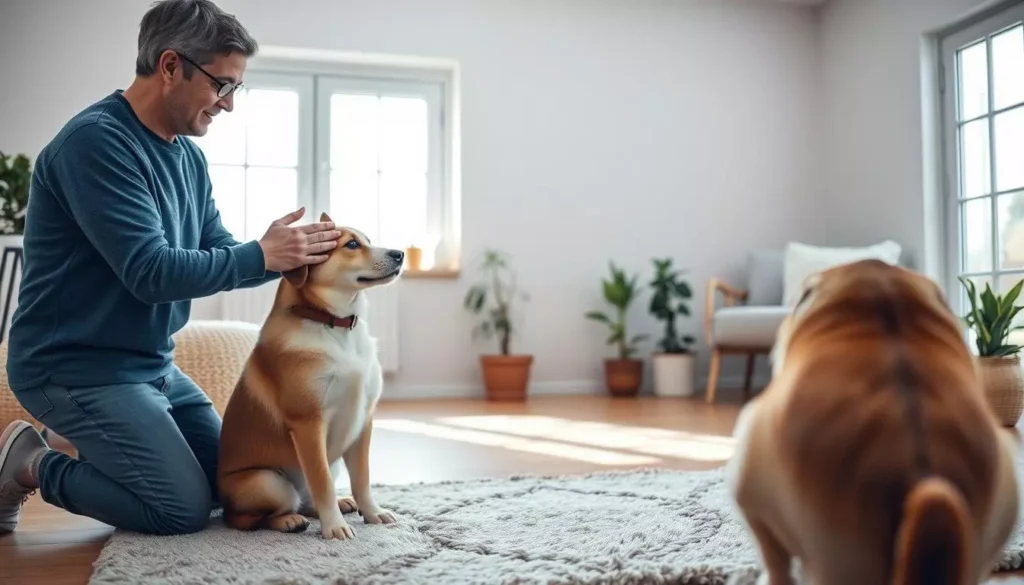
By focusing on these basics, I improve my dog's obedience and our communication. This makes my pet happier and better adjusted.
| Training Element | Importance | Method |
|---|---|---|
| Consistency | Helps the dog understand expectations | Use the same commands and signals each time |
| Positive Reinforcement | Encourages desired behaviors | Reward with treats or praise |
| Patience | Promotes a relaxed learning environment | Remain calm and composed |
| Engaging Methods | Keeps training lively and enjoyable | Incorporate games and varied activities |
The Role of Generalization in Training
Understanding generalization in dogs is key for good training. It means a dog can use what they've learned in many places and situations. If my dog only learns in one spot, their training won't be as useful. To help my dog learn more, I need to train them in different places and situations.
What is Generalization?
Generalization in dog training means a dog can use what they've learned in new places. For example, if my dog learns to sit at home, they should sit in the park or vet's office too. This helps my dog behave well in many places.
Why Generalization is Key to Dog Training
Adding generalization to training makes it better for my dog. Here's why it's important:
- Versatility: My dog can behave well in many places, making life easier.
- Confidence: Generalization helps my dog feel more confident in new places.
- Safety: A well-generalized dog is safer because they don't react badly to new things.
To get my dog to generalize, I need to be patient and keep training them in new places. This makes sure they understand the command in different situations.
Environmental Distractions Affecting Your Dog
Understanding how dogs focus is key when we think about what affects their training. Dogs are very observant and can get distracted by things like noise, movement, or smells. They often get caught up in what's happening around them, making training harder.
Training my dog in a busy place like a park or crowded street is tough. The distractions make it hard for them to listen to me. So, I choose quieter places for training. This helps my dog focus better and improves their overall attention.
I start by training my dog in quiet places first. Then, I slowly add distractions to their training. This helps them learn to stay focused, even when there's a lot going on. I do this slowly, so they can handle distractions better over time.
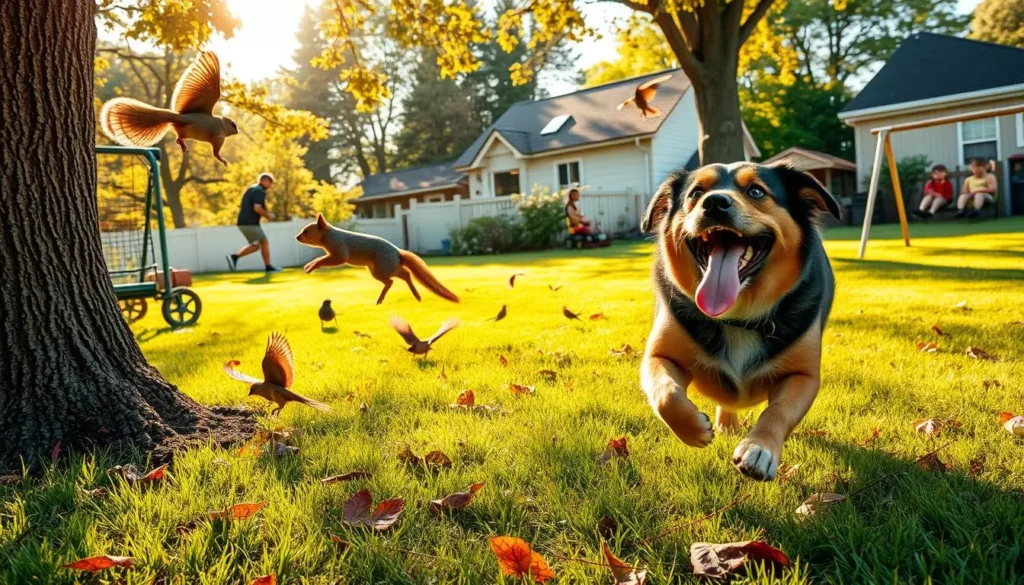
Your Dog's Age and Learning Capacity
The age of my dog is key to its learning and command response. Knowing the puppy training stages helps me tailor my approach. Puppies grow fast, both physically and mentally. Their focus and learning ability change at different stages.
This knowledge lets me set the right training goals and methods.
Understanding Puppy Development Stages
Puppies go through several stages that affect their learning. The early socialization period is from three to twelve weeks. It's when they get used to new things.
This period is crucial for their future learning. I focus on basic commands and social skills during this time. When they reach six months, they become more confident. I then move on to more complex tasks as their interest grows.
Adolescent Dog Training Phase
Adolescence brings independence and distraction to dogs. This stage is from six months to two years. Training at this time needs patience and consistency.
I adjust my training to match their changing abilities. Using motivational techniques helps keep them interested. Knowing this stage helps me train them effectively.
Using Effective Motivators
Finding the right motivators for dog training is key to success. Dogs love high-value treats that grab their attention. Low-value treats often don't work, causing frustration.
Choosing the right rewards can make a big difference. I use treats like small pieces of chicken or cheese. I also use interactive toys to keep my dog interested.
Using these treats consistently keeps my dog focused and eager to learn. Tailoring rewards to my dog's likes creates a positive learning environment. This approach not only improves obedience but also strengthens our bond.
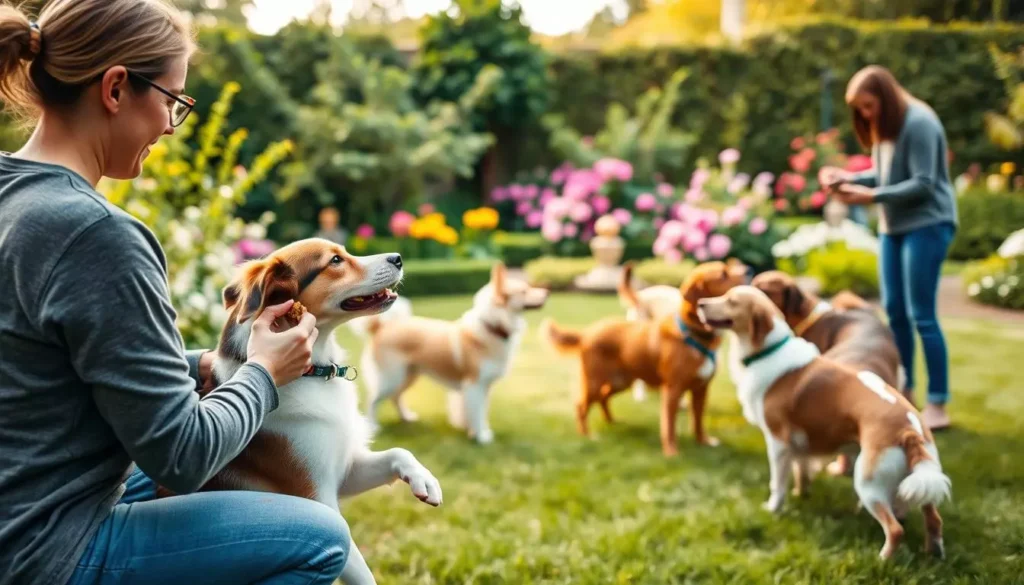
The Power of Positive Reinforcement
Positive reinforcement is key in shaping my dog’s behavior. It rewards my dog for good actions. This makes training fun and strengthens our bond.
Using rewards in training makes learning fun for both of us. It enriches our experience together.
High-Value Treats for Training
High-value treats are great for dog training. Slices of chicken or small cheese pieces are more appealing than regular kibble. They keep my dog interested and motivated during training.
Every time he does something right, he gets a tasty treat. This makes training more enjoyable and encourages him to learn more.
Building a Bond Through Rewards
Using positive reinforcement helps us grow closer. Rewards are a powerful way to communicate and build trust. They make my dog more responsive to my commands.
This system not only teaches him good behavior but also strengthens our bond. It makes our training journey more rewarding and fulfilling.
Common Training Pitfalls to Avoid
When I train my dog, I must watch out for common mistakes. One big one is being inconsistent with commands. If I use different words or signals for the same thing, my dog gets confused.
Being patient is key in training. If I get impatient, it can make us both frustrated. Rushing the training means my dog misses important lessons. Giving feedback at the right time helps them learn better.
Using only negative reinforcement is another big mistake. It can make my dog scared instead of understanding. If they think training is punishment, they might not listen. Using positive reinforcement helps us bond better.
Knowing these common mistakes helps me train my dog better. By avoiding these issues, I can help my dog learn faster and listen better.
Setting Realistic Expectations with Your Dog
Setting realistic dog training expectations is key to success. Knowing your dog's limits shapes your training approach. Each dog is different, with abilities changing over time due to age, temperament, and past experiences.
Understanding Your Dog's Limits
It's important to remember that dogs may not learn commands right away. Training takes time, and it's crucial to let your dog learn at his own pace. Breed, energy levels, and social history all impact what your dog can do. By understanding these limits, you can adjust your training methods.
Managing Your Own Expectations
Managing your own expectations is just as important as understanding your dog's. Training is not always straightforward, with ups and downs along the way. Being patient is vital during these times.
Accepting that challenges will come helps avoid frustration. This mindset improves your training and strengthens your bond with your dog.
When to Seek Professional Guidance
Dogs can show many behaviors that need more than usual training. It's key to know when to get a trainer's help for their growth. If my dog doesn't listen or follow commands, even with my best efforts, it's time for a pro. Trainers can spot issues and behaviors I might miss.
Getting advice from a dog trainer can make my training better. They offer strategies that fit my dog's special needs. They can also make changes and give tips right away. This not only helps with obedience but also makes our bond stronger.
| Indicators for Professional Training | Benefits of Professional Guidance |
|---|---|
| Sustained behavioral issues | Targeted strategies for improvement |
| Difficulty with basic commands | Expert insights into communication barriers |
| Lack of progress in training | Customized training plans for efficacy |
| Specific behavioral problems (e.g., aggression) | Individualized focus on behavioral issues |
| Overwhelmed by training challenges | Support for both dog and owner |
Conclusion
Understanding why my dog doesn't listen is complex. It involves communication, the environment, and training. I've learned that clear communication helps create a better space for my dog. This is key to improving obedience.
Using the right training methods helps me connect better with my dog. This way, he learns to respond well and consistently. It's all about building a strong bond through positive actions.
By focusing on trust and positive reinforcement, I've made a big difference. Trust is crucial for my dog to listen and obey better. With the right approach and understanding, we can achieve great things together.
It's important to manage our expectations. Recognizing what my dog can do and celebrating small wins helps a lot. This approach strengthens our bond and makes my dog happier and more obedient.

